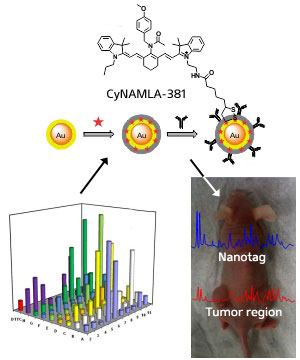| Aug 17, 2011 |
Bioimaging: Raman probes for cancer diagnostics
|
|
(Nanowerk News) Surface-enhanced Raman spectroscopy (SERS) is a powerful tool for detecting and analyzing chemicals. The technology has recently emerged as a non-invasive tool for imaging cells and nanotechnology cancer diagnostics. Compared with fluorescence microscopy and other conventional fluorescence-based imaging techniques, SERS does not suffer from the problem of photobleaching—degradation of the fluorescence of the probes used as a result of repeated light exposure. However, there remain very few SERS probes—typically made of gold nanoparticles coated with a highly sensitive 'reporter' compound—that are suitable for use in live cell imaging.
|
|
Young-Tae Chang at the A*STAR Singapore Bioimaging Consortium and co-workers have now demonstrated an efficient approach for finding highly sensitive reporter compounds that respond to light in the near-infrared (NIR) spectrum ("Ultrasensitive Near-Infrared Raman Reporters for SERS-Based In Vivo Cancer Detection"). "The major advantage of NIR light is that it can pass through the skin and penetrate much deeper into tissue compared with light in the visible spectrum," says Chang.
|
 |
| Combinatorial analysis gives the SERS intensity of the CyNAMLA library of compounds (bottom left), from which CyNAML-381 was found to be a highly sensitive reporter compound. A gold nanoparticle-based Raman proble bearing CyNAML-381 (top) can then be used to detect cancer by SERS (bottom right). (© 2011 Wiley-VCH)
|
|
Previous studies have identified 3,3?-diethylthiatricarbocyanine (DTTC) as a highly sensitive NIR reporter compound. The researchers synthesized 80 tricarbocyanine-based compounds structurally related to DTTC and examined them under a Raman scanner after attaching them to gold nanoparticles. They found that compounds with aromatic amine groups were most active. One of the compounds they found, named CyNAMLA-381, was 12 times more sensitive than DTTC itself.
|
|
The synthesis of different but structurally related materials is a common strategy used in the field of combinatorial chemistry. The approach is advantageous because it can lead to the quick and efficient discovery of novel materials. "With the discovery of CyNAMLA-381 as a highly sensitive NIR reporter compound, we were able to prepare SERS probes suitable for detecting breast cancer cells," says Chang.
|
|
The SERS probes were made by attaching CyNAMLA-381 and HER2-recognition motifs to the surface of bovine serum albumin-stabilized gold nanoparticles (see image). "The HER2 signaling pathway plays an important role in cell proliferation in most breast cancers," Chang explains. "The motifs are designed to selectively detect cancer cells expressing HER2 receptors."
|
|
The researchers tested the performance of the new SERS probes first on cells, then on mice. They received SERS signals only from cancer cells and breast tumors in mice, and not from normal cells or from other anatomical locations. "The high sensitivity and tumor specificity of these probes proves their excellent potential as non-invasive diagnostic tools, and opens up a new window for the development of SERS probes for cancer bioimaging," Chang adds.
|

